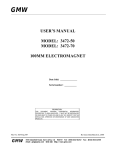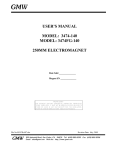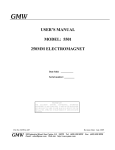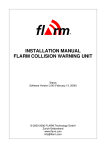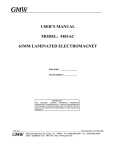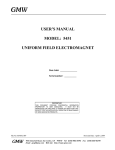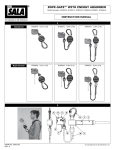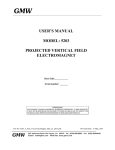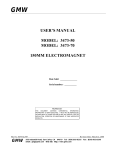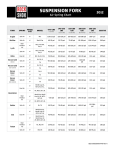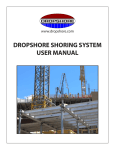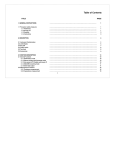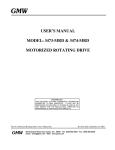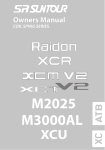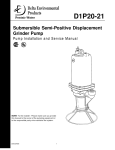Download USER`S MANUAL MODEL: 5403EG-20 (Air
Transcript
GMW USER’S MANUAL MODEL: 5403EG-20 (Air Cooled) MODEL: 5403EG-50 (Water Cooled) 76MM ELECTROMAGNET Date Sold: _______________ Serial number: ___________ PROPRIETARY THIS DOCUMENT CONTAINS CONFIDENTIAL INFORMATION PROPRIETARY TO GMW ASSOCIATES. IT MUST NOT BE REPRODUCED OR DISCLOSED TO OTHERS OR USED IN ANY WAY EXCECPT FOR THE INSTALLATION, OPERATION OR MAINTENANCE OF GMW ASSOCIATES PRODUCTS. File No: M5403EGd.407 GMW Revision Date: August 7, 2007 955 Industrial Road, San Carlos, CA 94070 Tel: (650) 802-8292 Fax: (650) 802-8298 Email: [email protected] Web site: http://www.gmw.com TABLE OF CONTENTS SPECIFICATIONS Table 1 Model 5403EG-20 General Specifications Table 1 Model 5403EG-50 General Specifications Table 2 Model 5403EG Electrical and Water Connections Section 1 WARNINGS [ Refer to this section before operation of Electromagnet ] Section 2 INSTALLATION Minimum Facility Requirements, and Equipment Checklist Unpacking Instructions Mounting Position Pole Installation and Setting Pole Gap Electrical Circuit Interlocks Cooling Section 3 OPERATION General Calibration Field Control Operation Section 4 MAINTENANCE Section 5 STANDARD OPTIONS Motorized Rotating Drive Probe Holder Section 6 CUSTOM OPTIONS Horizontal Mount Section 7 EXCITATION CURVES Section 8 TEST DATA Section 9 DRAWINGS Elmwood 3450 Thermostats Drawing 11901050 5403EG-20 Electromagnet General Assembly Section 10 Continued... DRAWINGS Drawing 11901080 5403EG-50 Electromagnet General Assembly Drawing 11901070 5403/P62B-4075 Electromagnet Electrical Assembly Drawing 13900430 5403/ P62B-4075 Electromagnet Electrical Wiring Drawing 11900740 5403/P62B-3066 Electromagnet Electrical Assembly Drawing 13900240 5403/P62B-3066 Electromagnet Electrical Wiring Drawing 11900240 5403/BOP20-40 Electromagnet Electrical Assembly Drawing 13900110 5403/BOP20-40 Electromagnet Electrical Wiring Drawing 13900090 5403/BOP20-20/20-20 Power Supply Electrical Wiring Drawing 11901180 5403 Electromagnet to Rolling/Rotating Base Assembly Drawing 11901160 5403 Electromagnet to Rolling Base Assembly Drawing 11901170 5403 Electromagnet to Rotating Base Assembly Drawing 11901190 5403 Electromagnet Assembly to Vertical Mount Drawing 11803430 Rolling/Rotating Base Assembly Drawing 11803170 Rolling Base Assembly Drawing 11802090 Rotating Base Assembly Drawing 17901610 5403 Electromagnet Vertical Mount Bracket Drawing 17901450 5403 Electromagnet Angle Bracket Drawing 11901140 5403 Cooling System Drawing 18900000 Electromagnet Tool Kit Drawing 17901390 Pole, Cylindrical (76mm) Drawing 17901400 Pole Spacer Drawing 17901470 Pole Retainer Drawing 18800282 Shipping Crate Assembly Section 1 SPECIFICATIONS Table 1. Model 5403EG-20 Specifications Pole Diameter: Pole Gap: [fixed, adjustable with spacers] Standard Pole Face: Coils (series connection) coil resistance (20°C) max resistance (hot)* max power (continuous) max power (peak) duty cycle (at peak power) Self Inductance Overtemperature Interlock Dimensions Weight 76mm (3 inch) 40mm (1.6 inch) minimum 150mm (5.9 inch) maximum 76mm (3 inch) cylindrical 38mm (1.5 inch) tapered 0.45 Ohm 0.55 Ohm 20A/10V (0.20kW) 75A/40V (3.0kW) 5%, 20 sec max on 60mH Elmwood 3450G thermostat part number 3450G 611-1 L50C 89/16 mounted on each coil and wired in series. Contact rating 120Vac,0.5A. Closed below 50°C. Drawing 11901050 582mm W x 270mm D x 359mm H 22.9 inch W x 10.6 inch D x 14.1 inch H 135 kg (297 lb) *CAUTION - The value of maximum coil resistance given should not be exceeded. At this resistance the coils are at maximum safe temperature for continuous operation. 1-1 Section 1 SPECIFICATIONS Table 1. Model 5403EG-50 Specifications Pole Diameter: Pole Gap: [fixed, adjustable with spacers] Standard Pole Face: Coils (series connection) coil resistance (20°C) max resistance (hot)* max power (continuous, air cooled) max power (continuous, water cooled) max power (peak) duty cycle(at peak power) Self Inductance Water Cooling (18°C) Overtemperature interlock Dimensions Weight 76mm (3 inch) 40mm (1.6 inch) minimum 130mm (5.1 inch) maximum 76mm (3 inch) cylindrical 38mm (1.5 inch) tapered 0.45 Ohm 0.55 Ohm 20A/10V (0.20kW) 50A/25V (1.25kW) 75A/40V (3.0kW) 30%, 120 sec max on 60mH 2 liters/m (0.5 US gpm) 0.8 bar (12 psid) Elmwood 3450G thermostat part number 3450G 611-1 L50C 89/16 mounted on each coil and wired in series. Contact rating 120Vac,0.5A. Closed below 50°C. Drawing 11901080 582mm W x 282mm D x 359mm H 22.9 inch W x 11.1 inch D x 14.1 inch H 141 kg (310 lb) *CAUTION - The value of maximum coil resistance given should not be exceeded. At this resistance the coils are at maximum safe temperature for continuous operation. 1-2 Section 1 SPECIFICATIONS Table 2. Model 5403EG Electrical and Water Connections DC Current (as seen from the front refer to Drawing 11901050/11901080) Right hand terminal: Negative Left hand terminal: Positive Ground An M6 screw (Item 16 on drawing 11901050/11901080) is inside the terminal cover to enable the magnet frame to be grounded according to local safety regulations. It is normally appropriate to connect the magnet frame to the power supply ground. Interlocks (refer to Drawing 11901050/11901080). The temperature interlock wiring connections are made directly onto the temperature thermostats (Item 10 on drawing 11901050/11901080). Water (refer to Drawing 11901080 5403EG-50 only). Outlet 1/8 inch NPT Inlet 1/8 inch NPT (mating couplings for 6mm [¼ inch] hose provided) CAUTION - Ensure that the high current connections are tight. Loose connections may lead to oxidation and overheating. The field stability may be degraded and the current terminations damaged. 1-3 Section 2 WARNINGS REFER TO WARNINGS BELOW BEFORE OPERATING ELECTROMAGNET 1 Personnel Safety In operation the magnet fringing field is in excess of 0.5mT (5G). This can cause malfunctioning of heart pacemakers and other medical implants. We recommend that the fringing field should be mapped and warning signs be placed outside the 0.5mT (5G) contour. Entry to this region should be restricted to qualified personnel. 3 Ferromagnetic Objects During operation the magnet exerts strong magnetic attraction towards ferromagnetic objects in the near vicinity of the pole gap or coils. Loose objects can be accelerated to sufficient velocity to cause severe personnel injury or damage to the coils or precision pole faces if struck. Keep ferromagnetic tools clear! 4 Arcing This magnet stores considerable energy in its field during operation. Do not disconnect any current lead while under load or the magnetic field energy will be discharged across the interruption causing hazardous arcing. 5 Coil Hot Resistance Do not exceed the maximum coil hot resistance given in the specifications or coil overheating and possible damage may occur. 6 Interlocks These should always be connected if the magnet is operated unattended, to avoid the possibility of coil overheating caused by excessive power dissipation or inadequate cooling. 7 Watches, Credit Cards, and Magnetic Disks Do not move magnetically sensitive items into the close vicinity of the magnet. Even some anti-magnetic watches can be damaged when placed in close proximity to the pole gaps during operation. Credit cards, and magnetic disks are affected by magnetic fields as low as 0.5mT (5G). Depending on the previous operating field and the pole gap, the remanent field in the gap can be in excess of 50G (5mT) with the magnet power supply off or disconnected. 2-1 Section 3 INSTALLATION Minimum Facility Requirements for Bipolar and Unipolar Systems installed in North America Floor Space: Magnet floor area: 604 x 270mm Total Mass: 141kg (310lb) Power Supply & Rack floor area: 700 x 900mm Total Mass: 100kg (220lb) An area for access to the Magnet and Power Supply must be provided. The total area for the system and comfortable operation is about 2 x 2m (6 x 6ft). The area should be clean and free from obstructions. Electrical Service: Bipolar System Unipolar System 2 x Kepco 20-20M 115Vac, Single Phase 50 – 60Hz 11A / Supply (22 Amps Total) Provided with Power Supply Nema 5-15R (US Standard) Or 6-15R if used with GMW Rack Provided with Power Supply 1 x Power10 P62B-3066 190 – 253Vac, Single Phase 50 – 60Hz 20 Amps 3 Conductor, 12AWG Min. Nema L6-20R or equivalent 115Vac, Single Phase 30A Nema L5-30P Nema L5-30R 115Vac, Single Phase 15A Nema 5-15P Nema 5-15R MPS Power: Power Supply: Voltage: Current: Power Cable: Mains Outlet: Mating Plug: Nema L6-20P or equivalent Auxiliary Power for Rack: Voltage: Current: Plug: Mating Receptacle: Note: Due to liability and insurance reasons, the mains power installation and connections for the Unipolar system must be completed by the facility electrician. Water Cooling: Water Temperature: 18°C Flow Rate: 2 liters / minute Pressure: 0.5 bar (8 PSID) Water Hose: 6mm I.D., rubber, 2 x 5m long minimum Plumbing Fittings: To connect 6mm hose to water source and drain. (It is recommended to have a water filter to trap debris on the facility water source and shutoff valves on the water source and drain.) System Computer (if not provided by GMW): Processor: Intel Pentium III, 500MHz PC or better Memory: 128MB RAM Free Drive Space: 500MB Interface: IEEE-488 (GIPB) Monitor Resolution: 1024 x 768 or better Operating System: Windows ME / 2000 / XP pro / NT4 Lifting Equipment for Installation: Forktruck or other lifting device with minimum safe lifting capacity of 250kg Nylon Slings with minimum safe lifting capacity of 250kg 3-1 Section 3 INSTALLATION Model 5403 System Installation; Equipment Check List General: Please provide this manual to the person who will be responsible for the System installation. If you need to discuss details of the installation please call GMW. If a GMW Engineer is to supervise the installation any delays caused by inadequate preparation may result in additional charges for Engineering Time. Site: ___ Floor space and work space cleared and ready for equipment. ___ Appropriate electrical services installed Materials Required: ___ Power Plugs ___ Power Cable ___ Cooling water supply installed with shut-off valves Materials Required: ___ 6mm I.D. water hose, 5m for source and 5m for drain. ___ Water hose fittings appropriate for installed plumbing. ___ Water hose clamps. 3-2 Section 3 INSTALLATION Caution: This is a heavy system. All movement, lifting and installation of the 5403EG Electromagnet must be under the supervision of an experienced person to prevent the possibility of serious injury or damage to the Electromagnet and associated equipment. Unpacking Instructions and Damage Inspection To unpack the electromagnet please use the following procedure (Refer to Drawing 18800282). 1. First remove all of the "Hex Head Screws" located at the lower edge of all the side panels of the "Crate Top Cover". 2. Gently rock the "Crate Top Cover" to work it loose from the shipping crate base. 3. Grip the side panels of the Crate Top Cover. Lift "Crate Top Cover" high enough to clear top of electromagnet, walk cover sideways to a clear area and place on floor. 4. Inspect the magnet to ensure that no damage has occurred to the magnet in shipment. If damage is evident report the damage in detail to the shipper for claim and simultaneously notify GMW in case assessment of the damage must be made. If no damage is found proceed with magnet unpacking and installation. 5. Remove the M12 Hex Head Coach Bolts that secure the magnet to the shipping crate base". 6. Install M10 lifting eye and washer to top of magnet yoke, screw down firmly. 7. The magnet is now prepared for final installation. Follow the appropriate procedure for direct or base mounting listed below. Direct Mounting 1. With suitable lifting equipment e.g. 250kg (550 lb) minimum safe lifting rating, lift magnet 50mm (2") clear of shipping crate base. 2. Slide shipping crate base clear. 3. Lower magnet to 50mm (2") above floor. 4. Move magnet to final location and bolt magnet down through the four mounting holes provided in the magnet angle bracket (Item 8 on drawing 11901050/11901080). 3-3 Section 3 INSTALLATION Pole Installation and Setting Pole Gap (Refer to drawing 11901050 for the Model: 5403EG-20 (air cooled) and drawing no11901080 for the 5403EG-50 (water cooled) ) Using the field uniformity and induction curves determine the most desirable pole; cylindrical or tapered. In general: If a uniform field is required use a cylindrical pole. If a high field is required use a tapered pole. Pole removal (Refer to drawing 11901050/11901080). 1. Turn off the power supply. 2. Loosen and remove the four pole retaining bolts and washers (item 12 & 18 on drawing 11901050/11901080). 3. Remove the pole taking care that the pole face is not damaged by contacting the magnet yoke. 4. Repeat this operation for the other pole. Pole fitting (Refer to drawing 11901050/11901080). 1. Ensure the poles and pole sleeves are clean and free from debris. 2. Slide on a pole spacer of the appropriate thickness to achieve the desired pole gap. 3. Reverse the above pole removal sequence above. Electrical Circuit Never connect or remove cables from the magnet with the power supply connected. The stored energy in the magnet can cause arcing resulting in severe injury to personnel or equipment damage. The magnet has two coils which are connected in series, (Refer to drawing 11901050/11901080). The power supply cables should be connected directly to the dc current terminals marked + and -. Recommended current cable for the 5403EG is stranded copper of 16mm² cross section (4 AWG). Because the magnet stores a significant amount of energy in its magnetic field, special care should be taken to insure that the current terminations are secure and cannot work loose in operation. Local heating at the terminations can cause rapid oxidation leading to a high contact resistance and high power dissipation at the terminals. If left unattended this can cause enough local heating to damage the terminals and the coils. The 5403EG Interlocks The Model 5403EG has two thermostats, Elmwood 3450G Part Number 3450G611-1 L50C 89/16. They are located at the center of the coil between the DC terminals and wired in series. The thermostats are normally closed, opening when the coil central cooling plate temperature exceeds 50°C +/3°C. 3-4 Section 3 INSTALLATION Cooling The Model 5403EG-20/5403EG-50 can be operated to an average coil temperature of 70°C. Assuming an ambient laboratory temperature of 20°C and a temperature coefficient of resistivity for copper of 0.0039/°C, the hot resistance of the coil should not exceed 20% more than the ambient temperature "cold" resistance. The coil thermostat will open when either coil temperature exceeds 50°C During operation the resistance can be checked using a voltmeter across each coil. The voltage will rise to a constant value once thermal equilibrium has been reached. If it is desired to save water, the flow can be reduced until the hot resistance is approached. NOTE: This adjustment must be made slowly enough to allow for the thermal inertia of the coils. 5403EG-50 [with water cooling] The cooling copper tubes are electrically isolated from the coils to avoid electrochemical corrosion. A 50 micron filter should be placed before the input to the magnet to trap particulates and avoid unreliable operation of the water flow switch interlock if fitted. For continuous operation of the magnet it may be appropriate to use a recirculating chiller to reduce water and drainage costs. The chiller capacity will depend on whether cooling is required for the magnet alone or magnet and power supply. For the model 5403EG-50 electromagnet alone a suitable chiller is the Bay Voltex Model: Mercury MC-50-E1-H1 with Flow Switch and Particle Filter Options. For recirculating cooling systems use distilled or deionized water with a biocide to prevent bacterial growth and corrosion. Do not use corrosion inhibitors in high quality electrical systems since the water conductivity is increased which can result in increased leakage currents and electrochemical corrosion. 3-5 Section 4 OPERATION General The magnet operates as a conventional electromagnet. 1. Set the poles to the desired gap using the appropriate thickness Pole Spacer (item 4 drawings no 11901050/11901080). Use equal spacers on each pole to maintain the pole faces symmetrical about the magnet center line. The minimum gap with standard poles in 40mm. 2. Turn on the power supply and increase the current until the desired field is reached. Calibration The induction curves may be used to estimate the field in the air gap to within four or five percent. More accurate field determination may be obtained by deriving experimentally a calibration curve for the particular pole and air gap combination being used. Magnetic hysteresis in the yoke and poles can cause an error of 30 to 70G (3 to 7mT) with an arbitrary application of such a calibration curve. This effect may be reduced to less than one percent by following a prescribed 'current setting schedule' designed to make the magnet 'forget' its prior magnetic history. The schedule should of course be used both in establishing the calibration curve and in its subsequent use. A possible schedule would be: From zero current, increase to maximum current and reduce again to zero current. Increase again to maximum current and reduce to the current to give the desired field setting. Approaching the desired field from a higher setting will typically produce better field uniformity. This is because the field changes at the pole edges will normally lag the field change at the center thereby helping to compensate the radial decrease in field. Greater precision in setting up the calibration curve will be achieved with the use of a digital teslameter and by making a numerical table. This table used with an interpolation routine will eliminate the error associated with reading a graph. In any event, three points need to be remembered: 1. A calibration curve or table is only as good as the precision employed in generating it. 2. The field is defined only at the point it is measured. It will generally be different at a different point in the air gap. For example, the induction curves refer to the field on the pole axis and at the center of the air gap (median plane). 3. The field is most directly a function of the current in the magnet coils. Voltage across the coils is not a good measure of field since the electrical resistance of the coils depends on the temperature (about 0.4% per degree celsius). 4-1 Section 4 OPERATION Field Control Operation The necessity to use calibration curves can be avoided by using a field controller to sense the magnetic field and provide a corresponding power supply control signal through the power supply programming inputs. Contact GMW for suitable instrumentation. 4-2 Section 5 MAINTENANCE Note that the surface treatments used provide good corrosion protection but in order to maintain the inherent mechanical precision of the magnet, heavy build-up of plating materials is deliberately avoided. As a result, high humidity, operation with cooling water at an inlet temperature below the dew point, or otherwise seriously corrosive atmospheres can cause corrosion. Periodically apply an appropriate corrosion protection, particularly when the magnet is stored for an extended period. Be very careful not to damage the relatively soft pole surfaces since this may degrade the magnetic field uniformity in the gap. 5-1 Section 6 STANDARD OPTIONS Section 7 CUSTOM OPTIONS Section 8 EXCITATION CURVES GMW Associates Electromagnet Excitation Plot Field Vs Gap Contract No: Customer: Page: 1 of 2 Model: Serial No: 5403EG 01 Power Supply: Serial No: Pole Face: Serial No: Pole Gap: Pole Spacers: 76 mm None Position: Notes: Date: Engr: May 29,2003 G.Douglas Set Current: Target Field: X=0, Y=0, Z=0 None 1.0 0.9 0.8 0.7 Current Field in Tesla 0.6 70A 50A 0.5 20A 0.4 0.3 0.2 0.1 0.0 40 50 60 70 80 90 100 Gap in mm Filename: 5403EG Gap-Field 110 120 130 140 150 160 GMW Associates Electromagnet Excitation Plot Field Vs Current Contract No: Customer: Page: 2 of 2 Model: Serial No: 5403EG Power Supply: Serial No: Pole Face: Serial No: Pole Gap: Pole Spacers: 76 None As per table below None Position: Notes: Date: Engr: June 25, 03 G.Douglas Set Current: Target Field: X=0, Y=0, Z=0 1.0 Approximate limit for continuous operation with convection air cooling +/-20A +/-10V 0.9 0.8 Gap mm 40 0.7 50 60 70 Field in Tesla 0.6 80 90 100 0.5 110 120 130 0.4 140 150 0.3 0.2 Maximum current for continuous operation with water cooling +/-50A +/-25V 0.1 0.0 0 10 20 30 40 Current in Amps Filename: 5403EG Ex 76-40-90 50 60 70 80 Section 9 TEST DATA Section 10 DRAWINGS DC OUTPUT DC OUTPUT























































